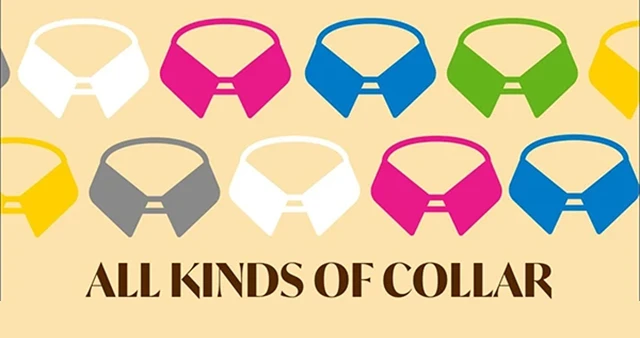
Types of Collar Workers
Understanding the diverse classifications in today's workforce
By Hassan Choughari, SHRM-SCP, FCIPD
Hassan Choughari is a Human Resource Director, Shared Services Director, HCM Consultant, Workforce Transformation Advisor, People and Culture Expert, CHRO, CSSO, University Lecturer, CIPD Tutor, and SHRM Certification Facilitator.
The terms "blue-collar" and "white-collar" were coined in the early 20th century by Upton Sinclair; these terms are occupational classifications that distinguish workers who perform manual labor from those who perform professional jobs.
Historically, blue-collar workers wore uniforms, usually blue, and worked in trade occupations. White-collar workers typically wore white, button-down shirts and worked in office settings. Other aspects that distinguish blue-collar and white-collar workers include earnings and education level.
Due to the new industries that happened after the Industrial Revolution a lot of Collar workers categories exist based on the colors of their collars worn as work; these can commonly reflect one's occupation or sometimes gender.
Some job categories involve duties that fall under one or more of the categories listed above or none of the above. These categories include:
Blue-Collar Worker
This term was first used in 1924; it is a member of the working class, who performs manual labor and earns an hourly wage. It originates from the popularity that blue color enjoys among manual-laborers.
White-Collar Worker
The term "white-collar worker" was coined in the 1930s by Upton Sinclair; it is a salaried professional, typically referring to general office workers and management. It originates from the color of dress shirts worn by professional and clerical workers.
Gold-Collar Worker
It was first used by Robert Earl Kelley in his 1985 book The Gold-Collar Worker; It is a newly formed phrase which has been used to describe either young, low-wage workers who invest inconspicuous luxury (often with parental support). It is also used to refer to highly-skilled knowledge people who are highly valuable to the company. Example: Lawyers, doctors, research scientists, etc.
Gray-Collar Worker
This refers to the balance of employed people not classified as white or blue-collar. Although grey-collar is something used to describe those who work beyond the age of retirement. Example: Firefighters, police officers, health care professionals, Security Guards, etc.
Green-Collar Worker
It was first used by Patrick Heffernan in 1976; it is a worker who is employed in the environmental sectors of the economy. Example: People working in alternate energy sources like solar panels, Greenpeace, World Wide Fund for nature, etc.
Pink-Collar Worker
It is employed in a job that is traditionally considered to be women’s work and is often low-paid. The term "pink-collar" was popularized in the late 1990s by writer and social critic Louise Kapp Howe especially those who perform jobs in the service industry example: nurses, secretaries, and elementary school teachers.
Scarlet-Collar Worker
This is a term often used to refer to people who work in the pornography industry, especially women entrepreneurs in the field of internet pornography. The color scarlet has traditionally been associated with adultery.
Orange-Collar Worker
Prison laborers, named for the orange jumpsuits commonly worn by inmates.
Yellow-Collar Worker
People in the creative field, They may spend time doing both white and blue-collar tasks as well as tasks outside either category example: Photographers, Filmmakers, Directors, Editors.
Red-Collar Worker
Government workers of all types and farmers. Derived from compensation received from red ink budget. Also in China, refers to Communist Party officials in private companies
Open-Collar Worker
This is a worker who works from home, especially via the internet.
Black-Collar Worker
This is used to referring to workers in the mining or the oil industry. Sometimes, it is also used to refer to people who are employed in black marketing activities.
Steel-Collar Worker or Chrome-Collar Worker
The phrase was first coined in the early '80s, referring to a robotic threat to the U.S. manufacturing jobs. A "steel collar workforce" is capable of tirelessly and efficiently performing repetitive tasks or monitoring. Things in the workplace that replace or augment human labor, like Computer-controlled smart tools and robots.
Popped-Collar Worker
If you come from a rich family but take 9-5 jobs for character building, you are among these popped collar workers. The collar also refers to young people who usually work at clubs, in stocks, or other fancy jobs.
Brown-Collar Worker
People working in Military services and Those who serve in the army like soldiers, army, navy, marines, air force, space force, and sometimes coast guard.
New-Collar Worker
Individuals who develop technical and soft skills needed to work in the contemporary technology industry through nontraditional education paths. The term was introduced by IBM CEO Ginni Rometty in late 2016 and refers to "middle-skill" occupations in technology, such as cybersecurity analysts, application developers, and cloud computing specialists.
Purple-Collar Worker
Some people say that it is a term describing someone who sells marijuana for a living. but that's not true as it is the skilled workers or consultants who blend entrepreneurial business savvy with a practical, technical ability doing both tasks for white and blue-collar example is information technology workers, engineers, and technicians.
No-Collar Worker
The new, exponentially emerging class rising up in America consisting of often over-qualified but unemployed persons or tech-industry professionals who eschew collars altogether, No collar individuals refer to artists or a free spirit who tend to privilege passion and personal growth over financial gain. You can call yourself as having no collar when you work for the satisfaction and not for payment.
These classifications highlight the diverse roles and industries that make up our workforce, showcasing the evolving nature of work in the modern era.